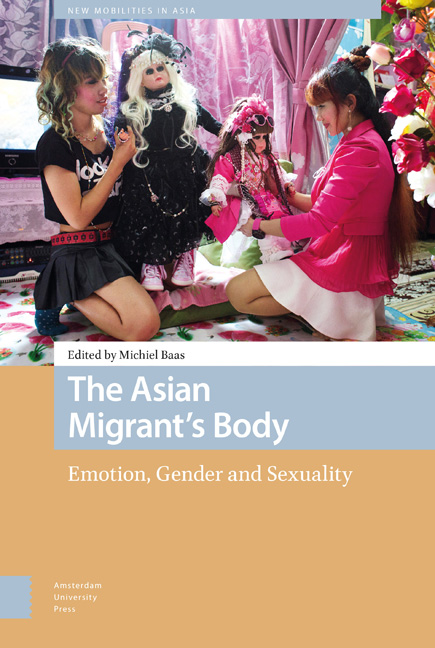Book contents
- Frontmatter
- Contents
- Introduction: Conceptualizing the Asian Migrant’s Body
- 1 ‘Not a Lesbian in Dubai, Not gay in Tehran’: Sexualities, Migrations, and Social Movements across the Gulf
- 2 Bodies at Work: Gendered Performance and Migrant Beer Sellers in Southeast Asia
- 3 Body, Space, and Migrant Ties: Migrant Domestic Workers and Embodied Resistances in Lebanon
- 4 The Day Off Policy , ‘Reverse Domestication’, and Emotional Labour among Indonesian Domestic Workers in Singapore: Maria Platt, Brenda S.A. Yeoh, Khoo Choon Yen, Grace Baey and Theodora Lam
- 5 Embodying the Good Migrant in Ageing: Negotiating Positive Subjectivities Through Paid Work
- 6 Proper Conjugation of Bodies: Chastity, Age, and Care Work in Sri Lankan Migrants’ Families
- 7 Border-crossing as Sexual Subjects: Interracial Dating Experience of Young Chinese in New Zealand
- 8 Managing Touch: The Racialized Dynamics of Intimacy in the Los Angeles Beauty Industry
- Notes on Contributors
- Index
Introduction: Conceptualizing the Asian Migrant’s Body
Published online by Cambridge University Press: 23 June 2021
- Frontmatter
- Contents
- Introduction: Conceptualizing the Asian Migrant’s Body
- 1 ‘Not a Lesbian in Dubai, Not gay in Tehran’: Sexualities, Migrations, and Social Movements across the Gulf
- 2 Bodies at Work: Gendered Performance and Migrant Beer Sellers in Southeast Asia
- 3 Body, Space, and Migrant Ties: Migrant Domestic Workers and Embodied Resistances in Lebanon
- 4 The Day Off Policy , ‘Reverse Domestication’, and Emotional Labour among Indonesian Domestic Workers in Singapore: Maria Platt, Brenda S.A. Yeoh, Khoo Choon Yen, Grace Baey and Theodora Lam
- 5 Embodying the Good Migrant in Ageing: Negotiating Positive Subjectivities Through Paid Work
- 6 Proper Conjugation of Bodies: Chastity, Age, and Care Work in Sri Lankan Migrants’ Families
- 7 Border-crossing as Sexual Subjects: Interracial Dating Experience of Young Chinese in New Zealand
- 8 Managing Touch: The Racialized Dynamics of Intimacy in the Los Angeles Beauty Industry
- Notes on Contributors
- Index
Summary
Introduction
A recent exhibition titled ‘Apples for Sale’ at Foam, a photography museum in Amsterdam, provides an overview of recent pictures by the photographer Rebecca Sampson, who has spent considerable time investigating and portraying the lives of Indonesian domestic workers in Hong Kong. The book that was published as part of the exhibition opens with a number of domestic workers wearing brightly coloured aprons of which a few sport the line ‘Apples for Sale’. These are pictures that could have originated from any agent brokering between domestic migrant workers and host families, however by introducing her work in this way, Sampson also seems to suggest that we can think of these women as literally for sale. Friendly, smiling, and with hands folded, the images convey eagerness and obedience; these women are clearly ready to serve. What follows could not provide a greater contrast. In a particularly striking picture, we see two female domestic workers walking through a part of Hong Kong that can only be thought of as its outskirts. Strewn with rubble and garbage on both sides, one of the women is dressed in a simple black top, miniskirt, and open-toe shoes with a pink strap, her toenails painted blue. The other, however, is dressed entirely in black, her hair cut short and gelled up in pointy spikes, her face covered in piercings, pants and shirt decorated with belts and various aggressive looking emblems. Immediately clear is that the two are in a lesbian relationship, one a girly girl, the other a tomboy. Perhaps even more striking, however, is that the latter is carrying a sizeable doll on her neck; dressed in white lace, the doll's hairdo and glittery tiara seem inspired by Japanese anime, though the shoes of a sturdy boots variety seem to mock the doll's cuteness. As subsequent pictures illustrate, the doll is used for the re-enactment of family life, something not just this couple engages in but quite a few other women employed as domestic workers in Hong Kong as well. They rent containers for 1400 HKD (or 160 EUR) per month and turn these spaces into private sanctuaries of candy-coloured wonderlands that, on Sundays (a mandatory day-off for domestic workers), provide a temporary safe-haven from the much harsher realities of day-to-day life and work during the week.
- Type
- Chapter
- Information
- The Asian Migrant's BodyEmotion, Gender and Sexuality, pp. 7 - 28Publisher: Amsterdam University PressPrint publication year: 2020



